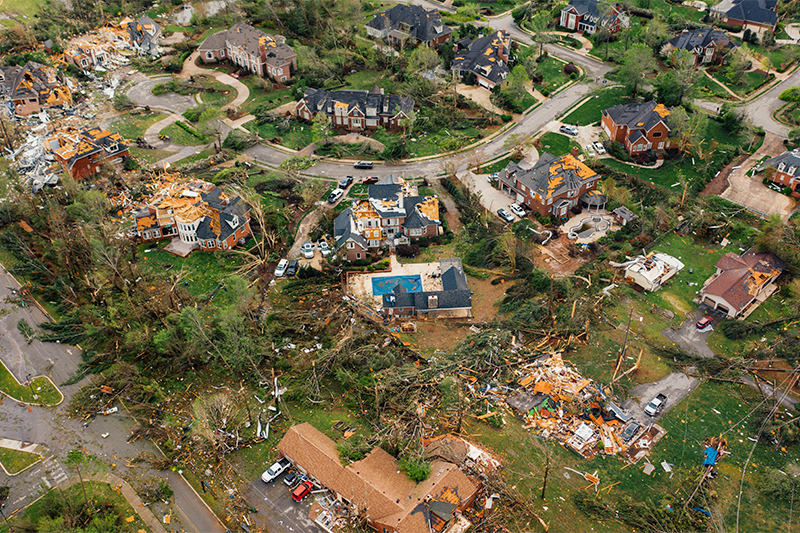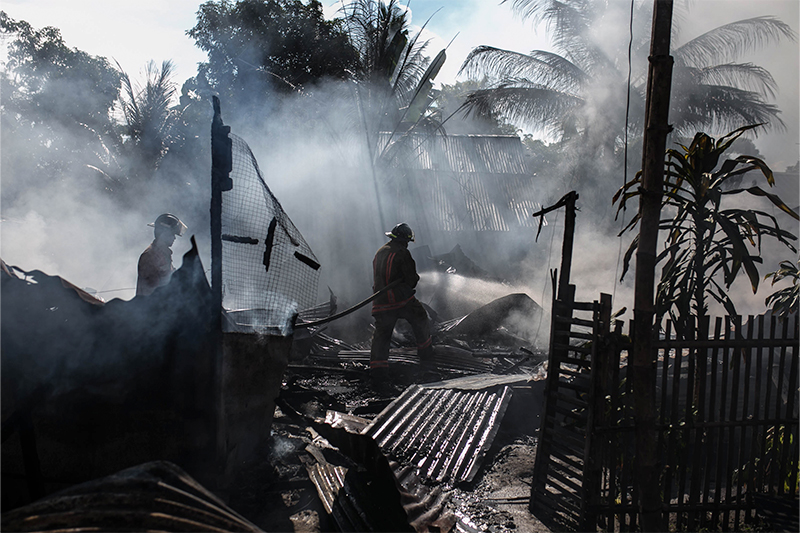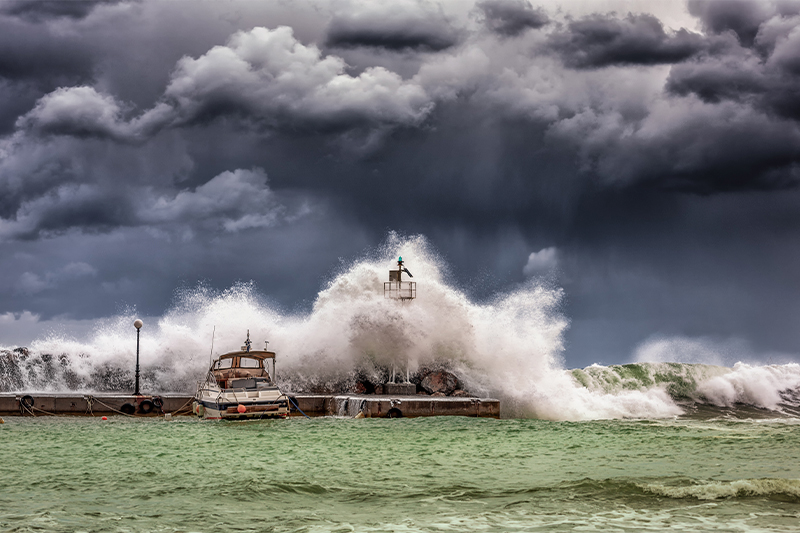
Above Average Hurricane Season & Winter
The National Oceanic and Atmospheric Administration (NOAA) released its latest advisory in July that an El Nino Winter could have severe impacts. Not only did they predict with 90% certainty that the above-average sea-surface temperatures that periodically develop across the east-central equatorial Pacific could impact the winter season but also the hurricane season. An above-average hurricane season is predicted.
So, El Nino impacting fall and winter weather means a wetter and colder season ahead. Additionally, although El Nino’s impact tends to decrease the effects of the Atlantic Hurricane Season, outlooks from Colorado State University are countering that. It means that since the Atlantic Ocean water is extremely warm in many areas, which could enhance storms. As practitioners, we must remain alert and plan for these potential risks.

Natural Hazard Risks Are Not A Joke
The number of Category 3 or higher storms is predicted to be three or greater for the Atlantic Basin, increasing the likelihood of onshore impacts. I issued a Summer 2023 Heatwave Warning, which adds to our risk awareness. Although natural hazards are the bread and butter of our work and sometimes may seem blase in light of the cascading risks from the pandemic, they’re not to be taken lightly.
My takeaway from The C-Suite’s 2023 Outlook On Crisis Preparedness is that we must be prepared for anything. I am likely talking to the choir here. I know that my emergency and crisis manager colleagues get this. And, likely for those in risk, safety, and security–you also understand the challenge. There’s much focus on business resilience and understanding business risk. I am certainly all for that. However, we must remain aware of the real danger that natural hazard events face and shouldn’t downplay their potential impacts.

How Severe Weather Impacts Business
An El Nino winter season and increased risk of severe hurricanes can impact business operations in various ways. Severe wet and cold winter weather can significantly impact business operations. Firstly, transportation and logistics can be severely disrupted. Heavy snowfall, icy roads, and freezing temperatures can make it difficult for employees and suppliers to commute to work or deliver goods and services. This can lead to shipment delays, reduced inventory levels, and disruptions in the supply chain. Additionally, severe weather conditions can damage transportation infrastructure, such as roads and airports, further hampering the movement of goods and people.
Secondly, the harsh winter weather can affect the physical infrastructure of businesses. Snow accumulation and freezing temperatures can lead to structural damage, such as roof collapses, burst pipes, or power outages. These issues can result in temporary or prolonged closures, causing a loss of revenue and potential damage to equipment or inventory. Moreover, businesses that rely on outdoor facilities or operations, such as construction, agriculture, or tourism, may face significant setbacks or complete shutdowns during severe winter weather, leading to financial losses and potential layoffs.
Overall, severe wet and cold winter weather can disrupt transportation, damage infrastructure, and hinder the functioning of businesses in various industries. Companies must have contingency plans to mitigate the impact of such weather conditions, ensure employee safety, and maintain continuity of operations.

Hurricanes Katrina, Sandy, Harvey, & Ian
Then, serious hurricanes are an increased risk, as well. A category three or higher hurricane can have a devastating impact on businesses. Firstly, it can cause extensive physical damage to buildings, infrastructure, and equipment. Strong winds, storm surges, and heavy rainfall can lead to structural collapses, flooding, and electrical failures, rendering businesses inoperable for an extended period. Secondly, the disruption to the local economy caused by a hurricane can result in a loss of customers and revenue. Mandatory evacuations, damage to transportation networks, and power outages can severely limit consumer activity, leading to decreased sales and financial losses.
Additionally, supply chains can be disrupted as suppliers and distributors in affected areas struggle to operate, causing delays or shortages in goods and services. Overall, the destructive force of a category three or higher hurricane can have far-reaching consequences for businesses, ranging from physical damage to financial setbacks and operational disruptions. I saw all of the effects and more as a responder to Hurricanes Katrina, Sandy, Harvey, and Ian. Each situation was different, but all had a long-term impact on their communities, people, and business. Resilient organizations plan to mitigate by learning from past events and leveraging innovations.

Enabling Severe Weather Resilience
To become resilient to the impacts of severe weather, businesses can take several measures:
- Develop a comprehensive emergency preparedness plan: Businesses should create a detailed plan that outlines specific steps to be taken before, during, and after severe weather events. This includes establishing communication protocols, identifying critical business operations, and ensuring employee safety. Regular drills and training sessions can familiarize employees with emergency procedures and improve overall readiness.
- Diversify supply chains: Businesses can reduce vulnerability by diversifying their suppliers and establishing backup options. Relying on multiple suppliers from different regions or having alternative transportation routes can help mitigate disruptions caused by extreme weather events in one specific area.
- Invest in infrastructure and risk mitigation: Upgrading infrastructure to withstand severe weather conditions can minimize damage and downtime. This includes reinforcing buildings, installing backup power systems, and implementing flood protection measures. Regular maintenance and inspections can also help identify and address potential vulnerabilities proactively.
- Utilize technology and data: Implementing advanced weather monitoring systems and data analytics can provide businesses with real-time information on impending severe weather events. This allows for better decision-making and timely responses, such as adjusting operations, rescheduling deliveries, or activating emergency protocols.
- Build strong relationships with stakeholders: Collaborating with local government agencies, emergency services, and neighboring businesses can enhance resilience. Sharing resources, information, and best practices during and after severe weather events can help companies to recover faster and support the overall community response.
- Consider insurance and risk management: Adequate insurance coverage, including policies addressing severe weather risks, can provide financial protection and aid recovery efforts. Risk management strategies, such as conducting regular risk assessments and implementing preventive measures, can help minimize potential losses.
Key Takeaways
By adopting these strategies, businesses can enhance their ability to withstand and recover from severe weather impacts, ensuring operations continuity and minimizing financial losses.

Remaining Risk Aware is Crucial to Resilience
Certainly, the risk of severe weather varies depending on geographic location and climatic factors. Certain regions, such as coastal areas prone to hurricanes or tornado-prone areas in “Tornado Alley” in the United States, have a higher risk of severe weather events. Other regions may face risks associated with extreme cold, heavy rainfall, or heat waves. Climate change also contributes to the increased frequency and intensity of certain weather events, such as hurricanes and wildfires, worldwide.
While it is challenging to quantify the exact magnitude of the risk, businesses need to recognize that severe weather events can occur and have the potential to disrupt operations and cause significant damage. Companies must assess their chances based on location, historical weather patterns, and climate projections. This allows them to develop appropriate strategies for resilience and risk mitigation.
Engaging with local meteorological services, monitoring weather forecasts, and staying informed about climate trends can help businesses prepare and make informed decisions regarding severe weather risks. Of course, following blogs like this can help as well. In the comment section below, let me know what sources you rely upon to understand risk.
Calling All Resilience Warriors!
Calling all resilience warriors! Don’t miss a beat with Disaster Empire – your gateway to groundbreaking insights and exclusive content!
Get ahead of the game by signing up NOW! Be an insider and be the FIRST to access our power-packed blog posts every Tuesday!
Unleash a world of knowledge with each blog – we’ve got it all! We’ve got your back from embedded links to source materials, captivating articles, eye-opening videos, must-read books, and top-notch training! Just click on the blue link to dive into an ocean of valuable resources!
Take resilience to new heights with our captivating podcast! Featuring exclusive interviews with thought leaders and innovators, this is YOUR ticket to inspiration and progress! Available on YouTube and YouTube Music for your ultimate viewing and listening pleasure!
Don’t wait! The excitement starts every Tuesday with our blog posts, and we’re not done yet – every Thursday, a fresh, invigorating podcast awaits you!
Join our growing community of change-makers and conquer challenges with Disaster Empire! Together, we’ll shape a resilient future!
